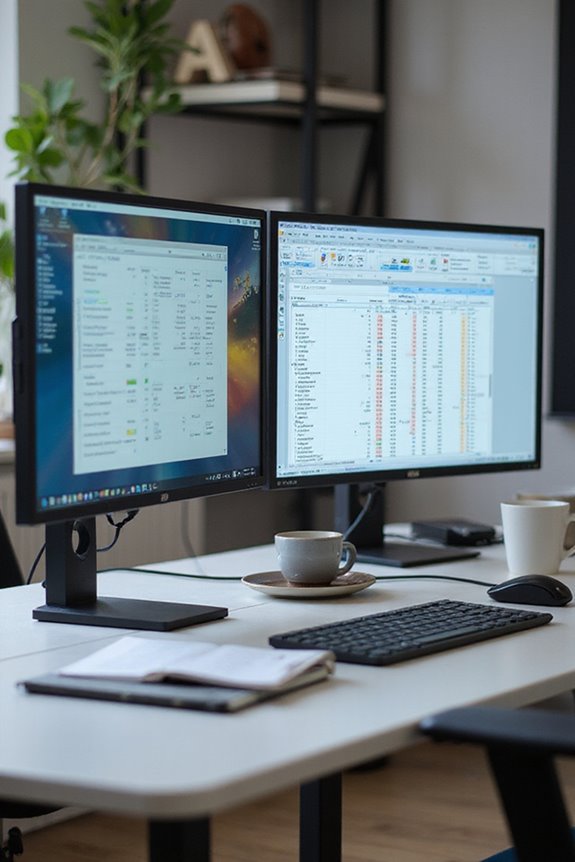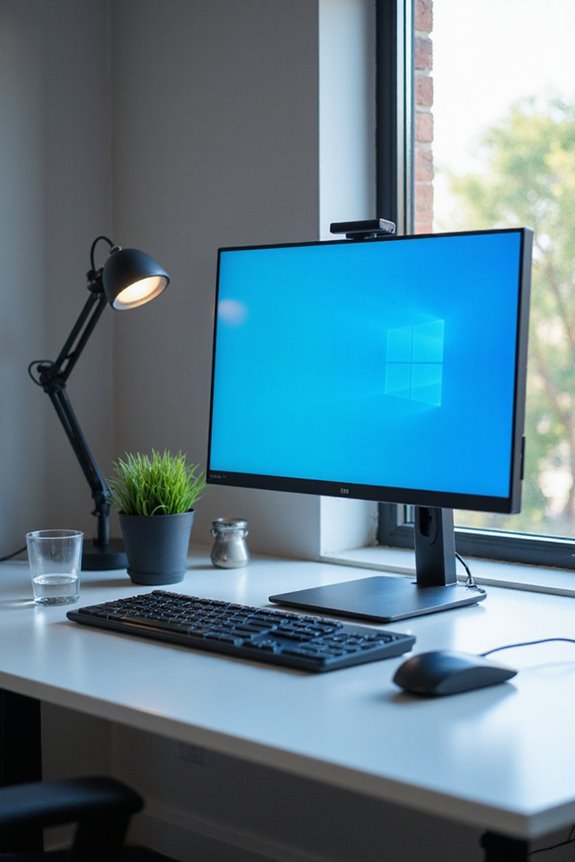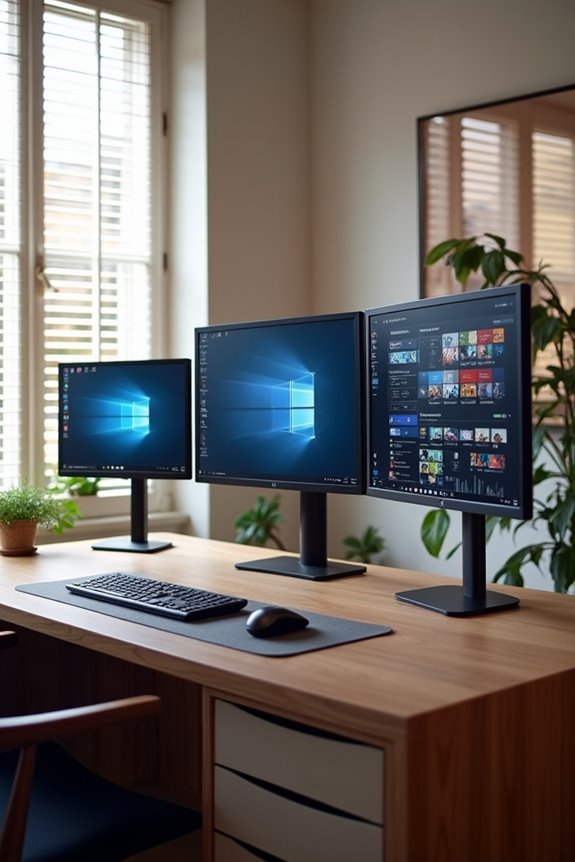Choosing a 4K or 1080p monitor for office productivity depends on your workflow and hardware. If you work with intricate details, a 4K monitor offers sharper images and more screen real estate, enhancing multitasking and focus. However, 1080p monitors are budget-friendly and sufficient for basic tasks. Consider your existing hardware, as 4K requires a more powerful setup. Assess your long-term needs carefully, and there’s more to explore about each option’s advantages and considerations.
Key Takeaways
- 4K monitors provide sharper images and improved text clarity, enhancing readability for detailed tasks compared to 1080p.
- Increased screen real estate with 4K allows for better multitasking and reduces context switching, boosting overall productivity.
- While 4K monitors are more expensive, they may offer longevity and better performance in evolving tech environments.
- 4K displays require more robust hardware, including a powerful GPU and sufficient RAM, compared to the minimal requirements of 1080p.
- Evaluate your current hardware and budget to determine if upgrading to 4K aligns with your long-term productivity goals.
Image Sharpness and Clarity
When it comes to image sharpness and clarity, the choice between 4K and 1080p can greatly impact your office productivity. 4K resolution boasts 3840 x 2160 pixels, offering around 8.3 million pixels, while 1080p provides just 1920 x 1080 pixels, totaling 2.1 million. This stark difference means 4K has four times the pixel count, resulting in a sharper image and improved text clarity. The higher pixel density in 4K displays notably enhances legibility, making text appear smoother and reducing pixelation. If you often work with small fonts or intricate details, that increased sharpness will be noticeable, particularly at closer viewing distances. Ultimately, opting for 4K can elevate your visual experience, leading to better focus and efficiency in your tasks. Additionally, many 4K monitors, such as the Philips 27E1N1800A, are designed with eye comfort features that can further enhance your productivity during long work sessions.
Productivity and Multitasking

While higher resolutions like 4K may seem like a luxury, they greatly enhance productivity and multitasking capabilities in an office environment. With 4K, I find that increased screen real estate allows for better screen organization. I can have multiple windows open simultaneously, which considerably improves task visibility and reduces the need for constant context switching. This setup not only helps me manage complex workflows more efficiently but also facilitates seamless collaboration when working with others. The detailed visuals in 4K make it easier to focus on tasks that require precision. Overall, investing in a 4K monitor can save time and boost productivity by enabling me to handle multiple tasks with ease and clarity. Additionally, having a monitor with high refresh rates can further enhance the smoothness of my workflow.
Cost and Value

As I evaluate the cost and value of 4K versus 1080p monitors, it’s essential to reflect on not just the initial outlay but also the long-term implications of each option. 1080p monitors generally fall within the $150 to $300 range, making them an attractive choice for budget-conscious users. Their cost efficiency is evident, especially since they can operate with existing office equipment and require minimal upgrades.
In contrast, 4K monitors start at higher price points, often exceeding $300, and necessitate additional investment in compatible hardware. While 4K may offer investment longevity in rapidly advancing tech environments, the lower operational costs and potentially longer lifespan of 1080p monitors present a compelling case for businesses prioritizing immediate budget constraints.
Performance and Hardware Requirements
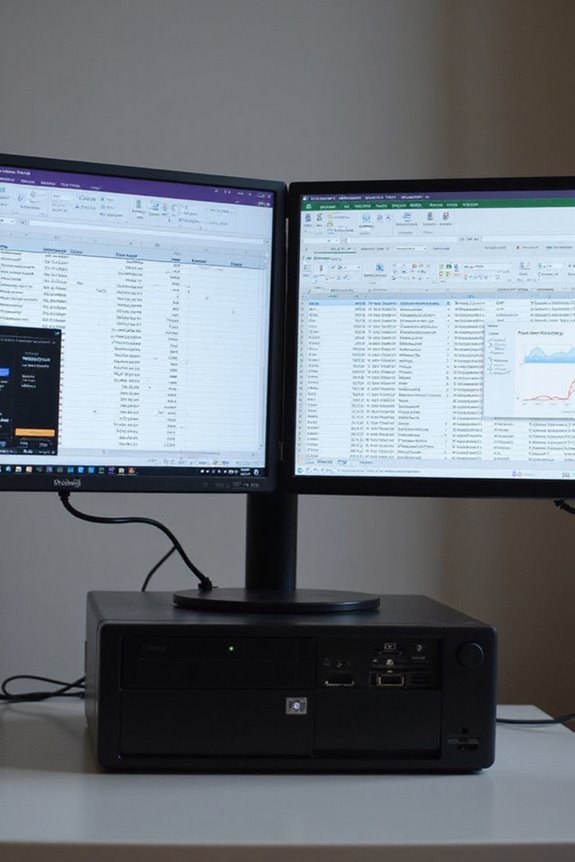
Understanding the performance and hardware requirements of 4K and 1080p monitors is vital for making an informed choice about your office setup.
- Resolution Impact: 4K monitors, with a resolution of 3840×2160 pixels, demand more from your system than 1080p monitors (1920×1080 pixels).
- Hardware Specifications: To run a 4K display effectively, you’ll need a robust GPU, a recent CPU, and at least 8 GB of RAM, with 16 GB recommended for peak performance.
- System Compatibility: Verify your connections meet the requirements, such as HDMI 2.0 or DisplayPort 1.4, to maintain high resolutions and refresh rates.
Choosing the right monitor is crucial, as your hardware directly influences the productivity and clarity of your work. Additionally, high color accuracy can enhance your visual experience, especially for tasks involving graphic design or detailed spreadsheets.
User Comfort and Experience
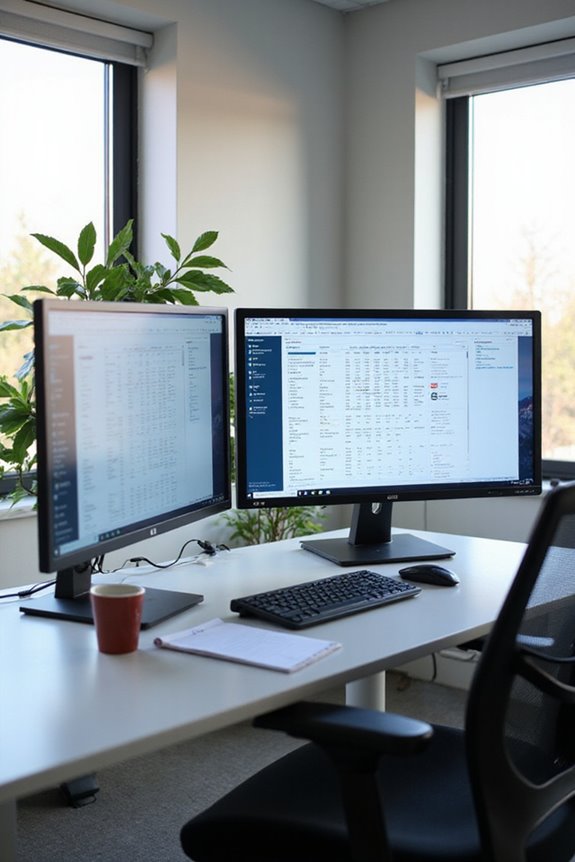
Choosing between 4K and 1080p monitors greatly impacts user comfort and overall experience in an office setting. Higher resolutions like 4K offer significant ergonomic benefits, including sharper visuals that reduce eye strain and enhance text readability. With four times the pixel density of 1080p, 4K displays provide clearer images, which leads to increased visual satisfaction, especially during extended use. Additionally, larger screens paired with higher resolutions accommodate more applications simultaneously, enhancing multitasking efficiency. This means I can work on various projects without sacrificing clarity. Overall, choosing a higher resolution monitor can create a more comfortable and efficient workspace, making daily tasks more manageable while promoting better posture and reducing visual fatigue. Furthermore, the 4K resolution ensures enhanced vividness and detail in visuals, making it ideal for both professional and casual use.
Use Case Suitability
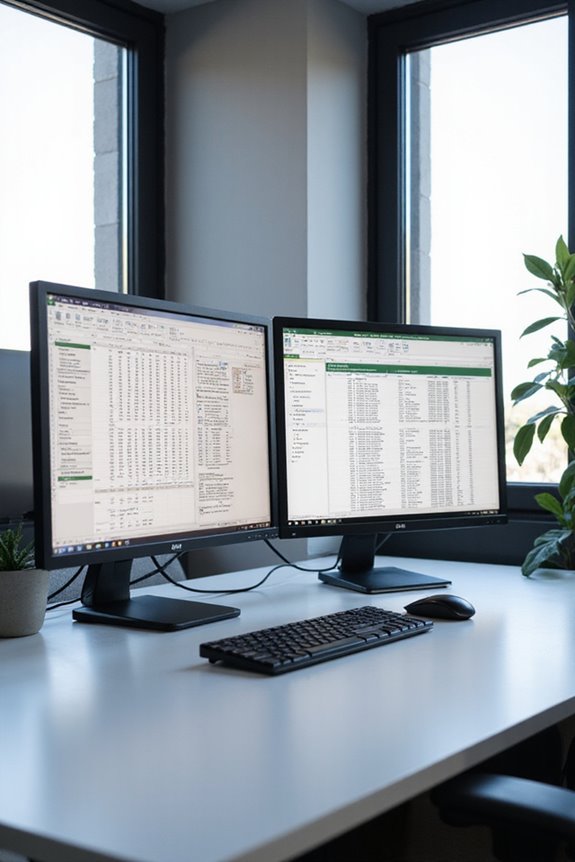
While evaluating the suitability of 4K and 1080p monitors for office tasks, it is essential to take into account the specific needs of your work environment. For basic office workflows, 1080p often meets task requirements effectively, especially for document editing, spreadsheets, and video conferencing. However, if your work involves graphic design, video production, or complex data analysis, a 4K monitor can greatly enhance clarity and detail, reducing eye strain during longer sessions. Additionally, if you’re working on a larger monitor, 4K provides more screen real estate, which can boost productivity through multitasking. Ultimately, aligning your choice with your specific tasks and budget will guarantee you select the right resolution for your office setup. A high refresh rate can further enhance the smoothness of your workflow, making it easier to switch between applications and manage multiple tasks simultaneously.
Benefits of 4K Monitors

As you consider the advantages of 4K monitors, it’s clear that they offer significant enhancements over their 1080p counterparts. The improved resolution allows for sharper text clarity and enhanced detail in images, which is essential for tasks requiring color accuracy. With 4K, you can keep multiple applications visible, reducing the need to switch between them and promoting efficient multitasking. Additionally, these monitors often come with integrated features that enhance collaboration, making them ideal for team environments. The display longevity of 4K monitors also guarantees that they remain relevant as technology evolves. Overall, investing in a 4K monitor can boost productivity and create a more professional workspace, making it a worthwhile consideration for anyone focused on office productivity.
Advantages of 1080p Monitors
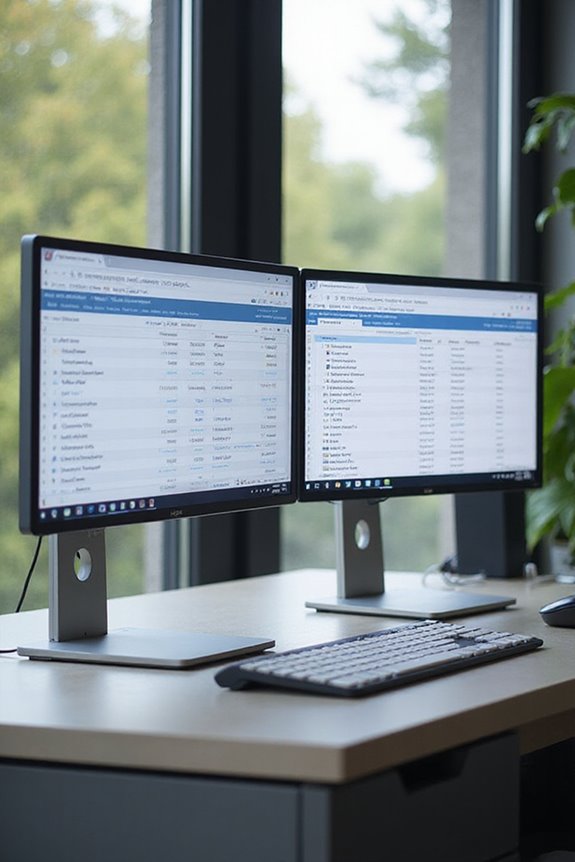
When considering the advantages of 1080p monitors, cost-effectiveness stands out as a primary benefit. These monitors are generally less expensive than their higher-resolution counterparts, making them accessible for budget-conscious buyers. Additionally, their gaming performance is impressive, often featuring high refresh rates that enhance the experience in fast-paced environments.
Power efficiency is another significant advantage; 1080p monitors consume less energy, which can lead to lower electricity bills over time. Their compatibility with smaller screens also offers a good balance between size and resolution, making them suitable for various office setups. Plus, they work well with most devices and software, ensuring you won’t run into compatibility issues. Overall, 1080p monitors provide a practical solution for everyday office tasks.
Considerations for Upgrading

As you contemplate an upgrade from a 1080p monitor to a 4K option, it’s essential to weigh the potential benefits against your specific needs and existing setup. First, consider your upgrade timeline. Are you planning to upgrade your computer as well, or will your current hardware support 4K? A budget assessment is also important; 4K monitors are typically more expensive and may require additional investments in compatible peripherals.
Evaluate whether the increased clarity and workspace efficiency provided by a 4K display align with your daily tasks. For professionals in creative or technical fields, the enhanced visual fidelity can be invaluable. Ultimately, understanding these factors will help you make a more informed decision.
Making the Right Choice for Your Needs
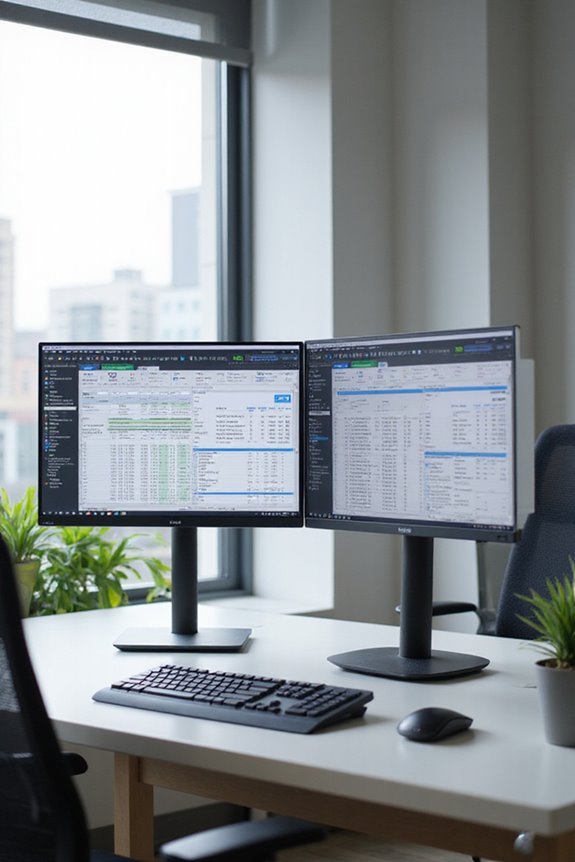
How do you determine whether a 4K monitor is worth the investment for your office productivity? First, consider your user preferences and the nature of your work. If you often multitask or work with detailed documents, a 4K monitor can enhance your productivity by providing sharper text and a wider workspace. However, if your tasks are mainly standard office work, 1080p may suffice and be more cost-effective.
Think about your long-term goals as well. If you plan to engage in graphics-intensive tasks or require high visual fidelity, investing in a 4K monitor could pay off in the long run. Assess your current hardware too—upgrading may require additional costs. Ultimately, choose what aligns best with your needs and budget.
Frequently Asked Questions
Can 4K Monitors Reduce Overall Power Consumption Compared to 1080P?
Honestly, 4K monitors can’t magically reduce power consumption like a superhero. They often consume more energy than 1080p models, so if power efficiency and energy savings are your goals, stick with 1080p for now.
What Types of Cables Are Needed for 4K Monitors?
For 4K monitors, I recommend using HDMI standards like 2.0 or 2.1 for superior performance. DisplayPort capabilities also provide excellent bandwidth, ensuring a smooth experience. Always check compatibility for the best results!
Do 4K Monitors Support Multiple Input Sources Simultaneously?
Can you imagine a monitor that can juggle multiple inputs like a circus performer? That’s what 4K monitors can do! They excel at screen sharing, making multitasking an absolute dream for any productivity enthusiast like me.
How Does 4K Affect Color Accuracy in Design Work?
I’ve noticed that 4K enhances color depth markedly, allowing for richer hues in my designs. By employing proper calibration techniques, I guarantee accurate color representation, essential for achieving the intended look across various mediums.
Are There Specific Brands Known for Quality 4K Office Monitors?
When I explore brand comparisons and monitor reviews, I find BenQ, Dell, and LG consistently praised for their 4K office monitors. Each offers unique features that enhance productivity and comfort in a professional setting.

